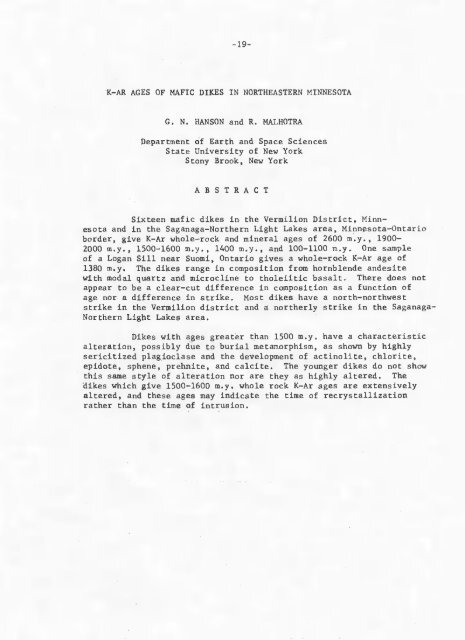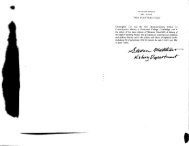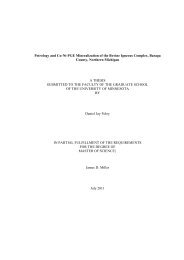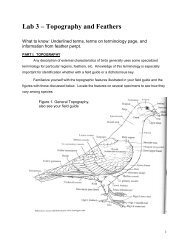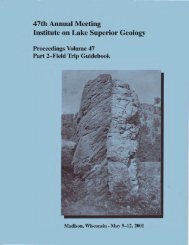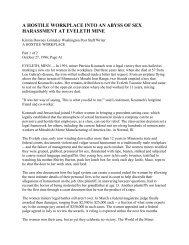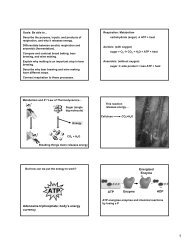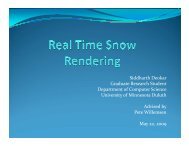Program, Abstracts, and Guidebooks - University of Minnesota Duluth
Program, Abstracts, and Guidebooks - University of Minnesota Duluth
Program, Abstracts, and Guidebooks - University of Minnesota Duluth
Create successful ePaper yourself
Turn your PDF publications into a flip-book with our unique Google optimized e-Paper software.
-19-<br />
K—AR AGES<br />
OF btkFIC DIKES IN NORTHEASTERN MINNESOTA<br />
C. N. HANSON <strong>and</strong> R. MALMOTRA<br />
Department <strong>of</strong> Earth <strong>and</strong> Space Sciences<br />
State <strong>University</strong> <strong>of</strong> New York<br />
Stony Brook, New York<br />
ABSTRACT<br />
Sixteen mafic dikes in the Vermilion District, <strong>Minnesota</strong><br />
<strong>and</strong> in the Saganaga—Northern Light Lakes area, <strong>Minnesota</strong>—Ontario<br />
botder, give K—Ar whole—rock <strong>and</strong> mineral ages <strong>of</strong> 2600 m.y.., 1900-<br />
2000 m.y., 1500—1600 m.y., 1400 n.y., <strong>and</strong> 100—1100 n.y. One sample<br />
<strong>of</strong> a Logan Sill near Suomi, Ontario gives a whole—rock K—Ar age <strong>of</strong><br />
.1380 m.y. The dikes range in composition from hornblende <strong>and</strong>esite<br />
with modal quartz <strong>and</strong> microcline to tholeiitic basalt. There does not<br />
appear to be a clear—cut difference in composition as a function <strong>of</strong><br />
age nor. a difference in strike. Most dikes have a north—northwest<br />
strike in the Vermilion district <strong>and</strong> a northerly strike in the Saganaga—<br />
Nor them Light Lakes area.<br />
Dikes with ages greater tjtan 1500 m.y. have a characteristic<br />
alteration, possibly due to burial metamorphism, as shown by highly<br />
sericitized plagioclase <strong>and</strong> the development <strong>of</strong> actinolite, chlorite,<br />
epidote, sphene, prehnite, <strong>and</strong> calcite. The younger dikes do not show<br />
this same style <strong>of</strong> alteration nor are they as highly altered. The<br />
dikes which give 1500—1600 m.y. whole rock K—Ar ages are extensively<br />
altered, <strong>and</strong> these ages may indicate the time <strong>of</strong> recrystallization<br />
rather than the time <strong>of</strong> intrusion.


